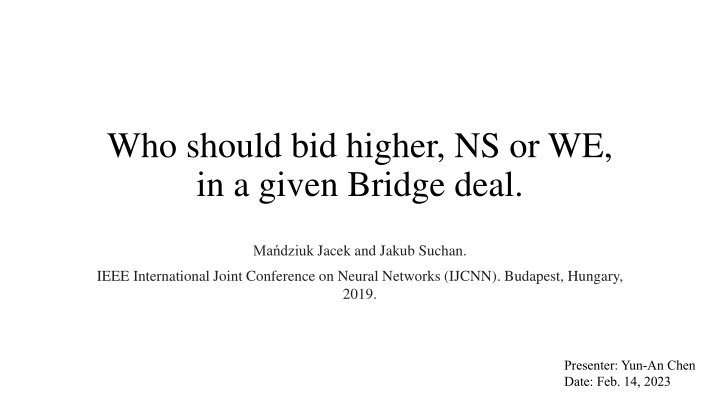
Who Should Bid Higher: NS or WE in a Bridge Deal Study
Explore a neural model that determines which pair, NS or WE, should bid higher in a Bridge deal through a Double Dummy Bridge Problem comparison. The study showcases a system trained using unsupervised and supervised phases, outperforming human-scoring systems. Experiment results indicate neural networks excel, especially in the trump contract.
Download Presentation

Please find below an Image/Link to download the presentation.
The content on the website is provided AS IS for your information and personal use only. It may not be sold, licensed, or shared on other websites without obtaining consent from the author. If you encounter any issues during the download, it is possible that the publisher has removed the file from their server.
You are allowed to download the files provided on this website for personal or commercial use, subject to the condition that they are used lawfully. All files are the property of their respective owners.
The content on the website is provided AS IS for your information and personal use only. It may not be sold, licensed, or shared on other websites without obtaining consent from the author.
E N D
Presentation Transcript
Who should bid higher, NS or WE, in a given Bridge deal. Ma dziuk Jacek and Jakub Suchan. IEEE International Joint Conference on Neural Networks (IJCNN). Budapest, Hungary, 2019. Presenter: Yun-An Chen Date: Feb. 14, 2023
Abstract(1/2) The paper proposes a neural model for a direct comparison of the two so-called Double Dummy Bridge Problem (DDBP) instances, along with a practical use-case for determining which pair, NS or WE, should propose the higher deal during a bidding phase in a Bridge game. The proposed system is composed of two identical subnetworks combined by a comparator layer placed on top of them. The base of each subnetwork is a shallow autoencoder (AE) which is further connected with a Multilayer Perceptron. The system is trained in two phases - an unsupervised one - used to create a meaningful feature-based input representation in AE compression layer, and a supervised one - meant for fine-tuning of the whole model. 2
Abstract(2/2) Training and test data are composed of pairs of Bridge deals in which the second deal in a pair is the first one rotated by 90 degrees. Since the task is to point which of the two deals promise a higher contract for the NS pair, due to deal rotation within a pair, the system effectively answers the title question Who should bid higher, NS or WE, in a given deal? . The proposed approach is experimentally compared with two other methods: one relying on a neural system solving the DDBP and the other one employing several estimators of hand strength used by experienced players. The results clearly indicate that both neural network approaches outperform the usage of human-scoring systems by a large margin, most notably in the trump (suit) contract. 3
Experimental setup Training set No trump: 800000 deals Trump: 800000 deals Testing set No trump: 400000 deals Trump: 800000 deals Training phase Autoencoder Fine-tuning of classifier 4
Autoencoder Compressed representation Encoder Decoder Input Output 208 208 104 / 156 5
